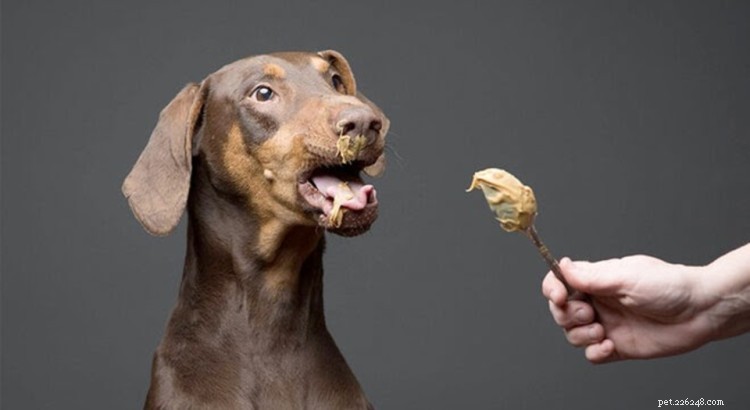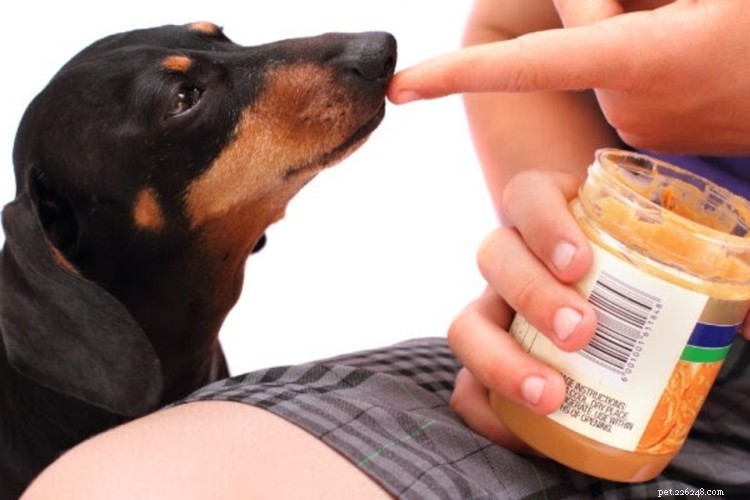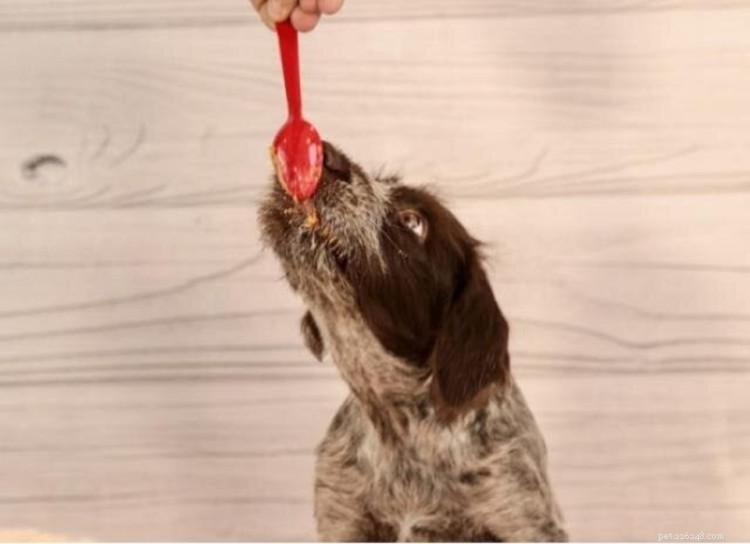Het lijdt geen twijfel dat puppy's dol zijn op pindakaas, maar is het echt goed voor hen? Hoewel pindakaas een ingrediënt is in veel commerciële hondensnoepjes, zal het antwoord je misschien verbazen.
Hoewel er veel merken pindakaas zijn die onschadelijk zijn voor uw hond, bevatten bepaalde soorten ingrediënten die schadelijk kunnen zijn voor honden. Dus voordat je je hond laat verwennen met pindakaas, zijn er een paar feiten die je moet weten.
Pro-tip :Is je hond erin geslaagd om een pot pindakaas te legen als je niet aan het kijken was? De rekeningen van dierenartsen kunnen duur zijn, maar het hebben van een hondenverzekering dekt de gevolgen van het binnenkrijgen van mogelijk giftige ingrediënten door uw huisdier en geeft u gemoedsrust.
 Bron afbeelding:Pin Paws
Bron afbeelding:Pin Paws
Pindakaas zit boordevol eiwitten, natuurlijke vetten, vitamine E, B en niacine. Grote hoeveelheden kunnen echter leiden tot obesitas en andere gezondheidsproblemen zoals pancreatitis.
De hoeveelheid pindakaas hangt af van de individuele hond, evenals van het merk pindakaas (controleer het aantal calorieën op het etiket). Over het algemeen zouden grotere honden één eetlepel moeten krijgen, terwijl kleinere honden niet meer dan een halve eetlepel per dag zouden moeten krijgen.
Bel uw dierenarts om te bespreken of pindakaas veilig is voor uw huisdier en hoeveel u moet geven. Dit is vooral belangrijk voor pups met onderliggende medische aandoeningen zoals diabetes, voedselovergevoeligheid of chronische pancreatitis.
Een ander ding om rekening mee te houden is de hoeveelheid pindakaas die je serveert. Onthoud de 90/10-regel:10% van het dieet van uw pup moet uit lekkernijen bestaan en de rest moet 90% uit hun normale hondenvoer bestaan. Het kan ook een goed idee zijn om af te wisselen tussen pindakaas en gezondere lekkernijen, zoals hondenveilig fruit en groenten.
Voor pups met chronische pancreatitis of degenen die risico lopen op het ontwikkelen van pancreatitis zoals Yorkshire Terriers en Dwergschnauzers - zelfs een kleine hoeveelheid vetrijke traktaties zoals pindakaas kan voldoende zijn om hun toestand te veroorzaken of te verergeren, dus het moet helemaal worden vermeden.
Als je harige vriend gevoelig of allergisch is voor bepaalde voedingsmiddelen of een speciaal dieet is voorgeschreven, is het het beste om veilig te blijven door ze te geven wat ze gewoonlijk eten.
Pups met nierproblemen mag geen pindakaas eten omdat het een hoog zoutgehalte kan bevatten waardoor hun toestand kan verergeren
Pindakaas bevat ongeveer 180-200 calorieën per twee eetlepels, waarvan de meeste afkomstig zijn van vet. Dit maakt het minder dan ideaal voor huisdieren met overgewicht . Als je op zoek bent naar trainingstraktaties, kies dan voor magere alternatieven zoals tonijn, kip en ham.
Als u de beste pindakaasoptie wilt kiezen, moet u het etiket controleren op conserveermiddelen en extra suiker. Sommige merken bevatten ook toegevoegd zout waardoor ze een hoog natriumgehalte hebben, evenals bepaalde vetten zoals palmolie. Je kunt het beste een pindakaasmerk vinden dat vrij is van toevoegingen of je eigen, zelfgemaakte versie bereiden met slechts één ingrediënt:pinda's.
Wees bij het lezen van het etiket voorzichtig met termen als "100% natuurlijk" of "geen kunstmatige zoetstoffen". Xylitol is technisch gezien een "volledig natuurlijke" zoetstof, maar kan extreem giftig zijn voor je harige metgezel!
Xylitol is een suikervervanger die wordt aangetroffen in suikervrije producten zoals tandpasta, gebak, supplementen, ijs en kauwgom. Deze kunstmatige zoetstof is volkomen veilig voor mensen, maar kan zeer giftig zijn voor honden.
Zelfs een extreem kleine hoeveelheid kan een snelle afgifte van insuline veroorzaken, wat op zijn beurt resulteert in een snelle verlaging van de bloedsuikerspiegel. Deze aandoening (hypoglykemie) kan binnen een uur na inname van xylitol optreden en kan, indien onbehandeld, fataal zijn.
Als uw harige vriend een product eet dat xylitol bevat, kan hij de volgende symptomen vertonen:
If you notice any of these symptoms, make sure to seek medical treatment right away. On your way to the vet, you can try to raise their blood sugar by rubbing maple or corn syrup on their gums, but this is only a temporary solution.
 Image source:Dogster
Image source:Dogster
Besides xylitol, peanut butter can contain other ingredients that can pose a threat to your dog’s health.
Most peanut butter contains aflatoxins, one of the most carcinogenic substances on the planet. Research has shown that aflatoxin can cause liver cancer in laboratory animals and is a risk for your pet as well. What’s worse, this toxic ingredient is even more common in the organic alternatives, as they’re not sprayed with glyphosate or other chemicals that kill it.
On the other hand, glyphosate, which is a common herbicide used by many major brands, can also cause health issues in dogs. According to NPIC, glyphosate symptoms in dogs include vomiting, diarrhea, lethargy, weight loss, and excessive drooling. Tests have also shown that 15% of dogs who eat grass treated with glyphosate herbicides develop serious symptoms of toxic reaction.
Lectins are proteins that can cause gut inflammation, irritating the cells lining the digestive tract and causing them to open up. This condition is called a leaky gut. When leaky gut is present, lectins escape into the bloodstream, where they trigger an inflammatory response. If inflammation persists, it might lead to chronic organ disease like arthritis, heart disease, kidney disease, allergies, and cancer.
Lectins also bind to sugars and carbohydrates in the body and interrupt messaging between inflammatory reactions and cells. In addition, they are anti-nutrients, i.e. they interfere with the proper absorption of important proteins, vitamins, and minerals.
You’ve probably heard that peanuts are rich in good omega-3 and omega-6 fats. The problem is, the ratio of these fats in peanut butter is highly unbalanced:a cup of peanuts contains 35.578 mg of omega-6 and only about 195 mg of omega-3s. That’s about 5000 times more omega-6 than omega-3!
When it comes to good fats, they’re only good if consumed in the correct ratio. Too much omega-6 can raise blood pressure, lead to blood clots, and cause the body to retain water. Omega-6 fatty acids are already represented in most of the foods your furry pal is exposed to, so feeding them peanut butter can only make things worse.
Trans-fatty acids are the result of hydrogenation, a process that makes foods more stable and more durable. They have been linked to chronic inflammation that can cause a number of diseases like heart disease and diabetes.
That’s why you need to check the label before buying peanut butter for your pooch. If you spot the words ‘hydrogenated’ or ‘partially hydrogenated oils’ in the ingredient list, stay away from it.
White sugar is responsible for feeding nasty things like bacteria, yeast, parasites, and even cancer cells. This means that the more sugar we (and our furry friends) consume, the more these grow and spread. Sugar can also lead to diabetes, premature aging, low-level inflammation, and food allergies.
While sudden, severe allergic reactions typical in people suffering from nut allergies are rare in dogs, other allergic symptoms might occur. To stay on the safe side, if you are feeding peanut butter for the first time, start with a very small amount and monitor your pet.
If you notice these symptoms after feeding peanut butter to your four-legged friend, stop immediately and get in touch with your veterinarian, who will be able to help figure out whether your pet is allergic to peanuts or something else. Also, make sure to speak to your vet before introducing any new foods to your dog’s diet.
Compare pet insurance policies to help you manage vet bills that might occur from treating an allergic reaction in your canine companion.
Enjoying your PB&J sandwich and wondering whether you should share it with your pooch?
While peanut butter can be safe for your four-legged friend if given in moderate amounts, jelly is an absolute no-no. This is because jelly, jam, and preserves contain lots of sugar. So, if you are already treating your dog with peanut butter, adding more sugar will increase the risk of diabetes and obesity even more.
Some jelly brands also contain xylitol and some types are made from fruits that aren’t dog-safe, like grapes. Grapes (as well as currants and raisins) can be toxic to dogs and cause acute kidney failure.  Image source:PetMD
Image source:PetMD
Here are a few fun ways to feed peanut butter to your four-legged pal:
Use it to give medication . Giving medication is often stressful as most pups won’t eat it plain. Use peanut butter’s deliciousness to conceal the flavor and texture of pills.
Make bathtime less stressful . Smear some peanut butter on the wall of your shower or tub to distract your pup during bath time (or while clipping their nails). They’ll be busy licking it and less focused on being shampooed, making the whole experience a lot easier for both of you.
Sweeten the entertainment . Fill a treat toy with some peanut butter and let your high-energy furry companion lick during chill out time.
Use it for training . Give some peanut butter to your pooch after they have shown good behavior or done what they were asked to do. This will make them more likely to do good again next time as they’ll remember getting an extra tasty treat.
The bottom line is, your canine companion can eat peanut butter as long as it’s fed in moderation and doesn’t contain xylitol . Don’t forget to alternate peanut butter with other healthy treats and you’ll make sure that your pup is satisfied.
If you have any questions or concerns about your pet’s diet, get in touch with your vet for recommendations and advice.